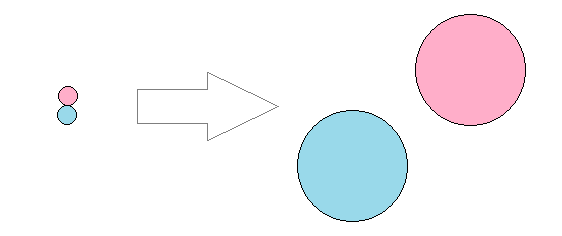Using this line of thinking, we had some success in explaining the field. Photons are double vortexes, consisting of six charged quanta. They interact attracting when they line up with the vortexes in harmony with each other. They repel when they line up the other way.
 |
| Photon consisting of six charged quanta |
Since photons whiz around at the speed of light, the best way to think about them is as snap-shots in which we can picture a particular physical connection. These physical connections, however brief and fleeting, transmit momentum from one photon to another.
With the universe full of low energy photons, there is an awful lot of interaction going on all the time. However, the photons do not form field lines. They bump into each other. It is the overall effect of being pulled more in one direction than the other that produces the field effect.
The photon is the structure dominating the universe. However, it is not the fundamental building block. Nor is it the simplest structure. What makes the photon the dominant structure, is its place in the energy hierarchy of things.
The photon is the most efficient way to store energy. It is therefore the preferred structure of the universe. It stores energy by growing in size. The six orbiting quanta widen their orbits when energy is added. The orbits become smaller when energy is lost. This is why blue photons are bigger than red photons.
The change in orbital size is instantaneous. There is no time delay. The change in energy is an either or thing. It does not always happen. But when it happens, there is no resistance to the change. This lack of resistance to change when it happens is what gives the photon zero inertia. It is also the reason why it is the most efficient storage of energy.
However, there is a limit to how much energy a photon can store. At very high energies, the photon becomes too large to be stable. Provoked by another photon to make a sudden twist, the high energy photon explodes into an electron-positron pair.
With the universe full of low energy photons, there is an awful lot of interaction going on all the time. However, the photons do not form field lines. They bump into each other. It is the overall effect of being pulled more in one direction than the other that produces the field effect.
The photon is the structure dominating the universe. However, it is not the fundamental building block. Nor is it the simplest structure. What makes the photon the dominant structure, is its place in the energy hierarchy of things.
The photon is the most efficient way to store energy. It is therefore the preferred structure of the universe. It stores energy by growing in size. The six orbiting quanta widen their orbits when energy is added. The orbits become smaller when energy is lost. This is why blue photons are bigger than red photons.
The change in orbital size is instantaneous. There is no time delay. The change in energy is an either or thing. It does not always happen. But when it happens, there is no resistance to the change. This lack of resistance to change when it happens is what gives the photon zero inertia. It is also the reason why it is the most efficient storage of energy.
However, there is a limit to how much energy a photon can store. At very high energies, the photon becomes too large to be stable. Provoked by another photon to make a sudden twist, the high energy photon explodes into an electron-positron pair.
 |
| Electron-positron pair produced from photon |
The electron and positron are each made up of only three quanta. They are simpler structures than the photon. But this does not make them physically smaller. They are bigger than most photons. They can store way more energy than a photon. However, they are less efficient as energy storage. It takes time to make a change in the amount of energy stored in an electron or positron.
The time delay between energy applied and energy absorbed by an electron or positron is what we call inertia. Inertia is not a property of the charged quanta, but a property of the structures they make up. The extremely simple structure of electrons and positrons have inertia due to the way they absorb energy. The more complex structure of photons have no inertia due to their instantaneous energy absorption.
The time delay between energy applied and energy absorbed by an electron or positron is what we call inertia. Inertia is not a property of the charged quanta, but a property of the structures they make up. The extremely simple structure of electrons and positrons have inertia due to the way they absorb energy. The more complex structure of photons have no inertia due to their instantaneous energy absorption.
No comments:
Post a Comment